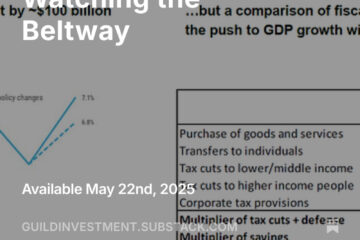Interest Rates, Inflation, and the Fed’s Coming Gut Check
This morning’s CPI print hit 7.5% year-over-year, up 0.6% from the previous print, and slightly worse than expected. Some (not us) had believed that December’s number would be a peak; it was not. Given trajectories of energy and housing costs, February seems likely to be higher still.
With 10-year rates taken to 2% this morning by the CPI release, do we see them stopping at 2%? No; we see 2.5% as a more likely peak before the Fed blinks and walks back taper talk, or even re-accelerates the pace of asset purchases.
In the longer run, as the Fed’s lack of resolve in its inflation battle becomes apparent, we agree with those analysts who see forms of credit control becoming more prominent, onerous, and difficult. As in the early 70s, we may see efforts to constrain inflation directed not where they should be — towards excessively loose monetary and fiscal policy — but towards wage and price controls (demonizing the very workers and businesses who are suffering from inflation as if they were its cause). Wage and price controls have a universal history of economic failure, but that doesn’t mean they might not be tried again.
Mr. Biden is a pro-labor president, and it is very unlikely that he will institute wage controls prior to the November mid-terms. Price controls, however, are more likely to be implemented. Although it hasn’t been announced as such, subtle credit controls via market manipulation of the Treasury bond and agency bond markets have going on for years — QE in essence acts as such a form of manipulation. These efforts will be expanded.
Market Behavior
Markets have seen a relief rally, retracing a little more than half of the decline from recent all-time highs. Earnings have seen some unprecedented and wild swings, including Meta’s [FB] epic drop on its first decline in daily active users and disappointing forward guidance. The move to the “metaverse” may indicate that FB has saturated its market and is working to build a new one in virtual reality — and that will be an expensive proposition.
It’s not just FB, though; earnings are coming off the acceleration of the pandemic period, and returning more to normal trajectories. The question is whether they continue at their historically normal pace, or if they are challenged because a good deal of growth was pulled forward, and the normalization period will be more prolonged.
While a retest of the market’s lows seems a distinct possibility, we cannot escape the observation of the trillions of dollars that remain on the sidelines, waiting to “buy the dip.” Therefore, we are focused on diversification across a range of stocks with superior earnings growth and quality and some visibility of catalytic events to spark investor enthusiasm, as well as long-term opportunity, provided it comes at a reasonable price.
The year so far has provided plenty of bearish data points. Even with all those, the broad market is behaving fairly well — which implies to us that it is in a process of digestion, not disintegration. We note that this digestion process is more mature than you might think — while the broad markets only really began to show it in January, the process has been visible in the more speculative and extended tech names since November 2021.
One thing we are bearish on is the purchasing power of fiat currencies — and therefore we include gold and gold shares as long-term elements of a diversified portfolio. We believe crypto will increasingly play that role as well, even though now it tends to trade in line with speculative tech stocks.
Supply Chains
The transmogrification of global supply chains from a “just in time” philosophy to a “just in case” mentality is ongoing. The replenishment and increase of stockpiles likely means that we have another two years of supply chain kinks ahead of us to work out. A headline came across the tape today that globally, copper stocks stand at about a three-day supply. Market volatility or no market volatility, the Fourth Industrial Revolution proceeds apace, and it is hungry for copper, as well as other essential inputs, from tech-adjacent commodities to chips. We think some chip manufacturers participating in the reshoring of semi capacity to the U.S. are interesting at this juncture.
Crypto Hacks Again In the News
Our coverage of the Qubit hack last week was timely; the even larger Wormhole hack happened just after and was another manifestation of exactly the problem we observed. Smart contracts were written with deprecated code that allowed malicious actors to siphon value out of a blockchain — in this case, the vulnerability was exposed in a project bridging the Solana and Ethereum blockchains (two powerhouses of the move to “defi,” or decentralized finance). The hack was worth $320 million, and injured parties were made whole by the project’s management. Again, this illustrates the reality that as crypto matures, so must the commitment of projects to the highest level of code auditing and verification. We think the winning platforms will be those that “bake in” the necessary stringency in process and programming.
Big Regulatory Change For Short Sellers?
The SEC seems to be coming out of hibernation on a number of important issues. Notably, there may be forward movement on next-day settlement. Should this become the norm, it would deeply challenge many short-sellers, particularly the more unscrupulous, as it would remove a 24-hour window for them to cover their trades. (We are not philosophically opposed to short-selling, which can serve a valuable purpose for markets as it incentivies the discovery of hidden negative information about companies — we’re just opposed to short-selling that skirts the bounds of legality.) Many small and micro-cap stocks suffer egregiously at the hands of such unscrupulous short-sellers — and should next-day settlement go into effect, we might anticipate a rally in many of these shares.
Thanks for listening; we welcome your calls and questions.



